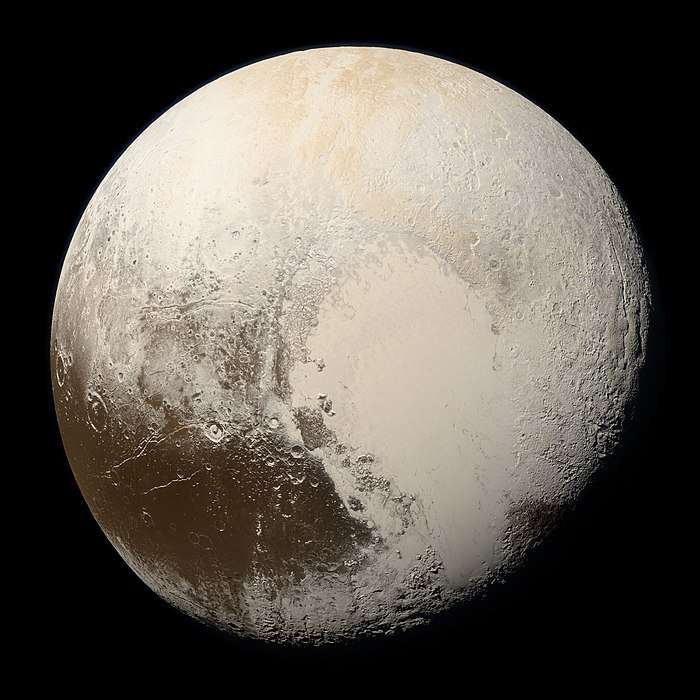(82075) 2000 YW134
(82075) 2000 YW134, provisionally known as 2000 YW134, is a binary trans-Neptunian object (TNO). It is likely in 3:8 resonance with Neptune or possibly a detached object.
| Discovery[1] | |
|---|---|
| Discovered by | Spacewatch |
| Discovery site | Kitt Peak Obs. |
| Discovery date | 26 December 2000 |
| Designations | |
| (82075) 2000 YW134 | |
| 3:8 resonance?[2] Detached? | |
| Orbital characteristics[1] | |
| Epoch 13 January 2016 (JD 2457400.5) | |
| Uncertainty parameter 3 | |
| Observation arc | 5546 days (15.18 yr) |
| Aphelion | 75.202 AU (11.2501 Tm) (Q) |
| Perihelion | 41.238 AU (6.1691 Tm) (q) |
| 58.220 AU (8.7096 Tm) (a) | |
| Eccentricity | 0.29169 (e) |
| 444.24 yr (162257 d) | |
| 29.643° (M) | |
| 0° 0m 7.987s / day (n) | |
| Inclination | 19.7774° (i) |
| 126.9457° (Ω) | |
| 317.10° (ω) | |
| Known satellites | S/2005 (82075) 1[3] (≈237 km in diameter) |
| Earth MOID | 40.2806 AU (6.02589 Tm) |
| Jupiter MOID | 36.2543 AU (5.42357 Tm) |
| Physical characteristics | |
| Dimensions | ≈455 km[4] <500 km[5] |
| >0.08[5] | |
| B−V=0.92; V−R=0.55[6] | |
| ≈21.5[7] | |
| 4.74,[6] 4.9[1] | |
Physical characteristics
Assuming a generic TNO albedo of 0.09, the primary is about 431 kilometres (268 mi) in diameter with its secondary at 237 kilometres (147 mi) in diameter.[3][4] In 2010, (82075) 2000 YW134 was observed by the Herschel Space Telescope in the far-infrared. No thermal radiation has been detected, which allowed astronomers to place an upper limit on its size; the single-object diameter should be less than 500 kilometres (310 mi).[5]
In the visible part of the spectrum, the surface of (82075) 2000 YW134 is moderately red.[6]
Classifications
- Possible dwarf planet
With a generically estimated diameter of 430 kilometres (270 mi), (82075) 2000 YW134 is a possible dwarf planet.[8]
- Uncertain category
(82075) 2000 YW134 currently has a perihelion distance of 41 astronomical units (AU).[1] In 2006, Lykawka, using a 4–5 Gyr integration, indicated that (82075) 2000 YW134 is a detached object with perihelion larger than 40 AU. However, the Deep Ecliptic Survey, using a 10My integration (last observation: 2007-11-10), shows it to be in 3:8 resonance with Neptune, with a minimum perihelion distance of 38.1 AU.[2] In 2007, Emel’yanenko and Kiseleva showed an 84% probability that it is in the 3:8 resonance.[9]
Satellite
The moon of (82075) 2000 YW134 is relatively large compared to the primary, because the moon is only 1.3 magnitudes fainter than the primary.[10]
References
- "JPL Small-Body Database Browser: 82075 (2000 YW134)" (last observation: 2007-11-10). Retrieved 7 April 2016.
- Marc W. Buie. "Orbit Fit and Astrometric record for 82075" (last observation: 2008-11-10 using 77 of 78 observations over 7.9 years). SwRI (Space Science Department). Retrieved 13 October 2014.
- Wm. Robert Johnston (4 March 2006). "(82075) 2000 YW134". Johnston's Archive. Retrieved 7 October 2009.
- Wm. Robert Johnston (5 July 2013). "List of Known Trans-Neptunian Objects". Johnston's Archive. Retrieved 5 December 2013.
- Muller, T.G.; Lellouch, E.; Stansberry, J.; et al. (2010). ""TNOs are Cool": A survey of the trans-Neptunian region I. Results from the Herschel science demonstration phase (SDP)". Astronomy and Astrophysics. 518: L146. arXiv:1005.2923. Bibcode:2010A&A...518L.146M. doi:10.1051/0004-6361/201014683.
- Stephen C. Tegler. "Kuiper Belt Object Magnitudes and Surface Color". Archived from the original on 1 September 2006. Retrieved 1 August 2010.
- "AstDyS (82075) 2000YW134 Ephemerides". Department of Mathematics, University of Pisa, Italy. Retrieved 6 October 2009.
- Mike Brown. "The Dwarf Planets". Retrieved 7 October 2009.
- Emel’yanenko, V. V; Kiseleva, E. L. (2008). "Resonant motion of trans-Neptunian objects in high-eccentricity orbits". Astronomy Letters. 34 (4): 271–279. Bibcode:2008AstL...34..271E. doi:10.1134/S1063773708040075.
- Stephens, Denise C.; Noll, Keith S. (2006). "Detection of Six Transneptunian Binaries with NICMOS: A High Fraction of Binaries in the Cold Classical Disk". Astronomical Journal. 131 (2): 1142–1148. arXiv:astro-ph/0510130. Bibcode:2006AJ....131.1142S. doi:10.1086/498715.
_(cropped).jpg)
